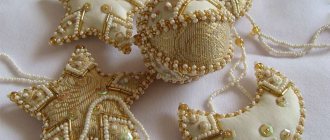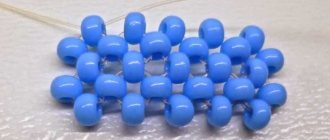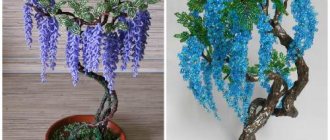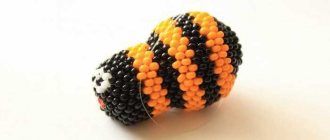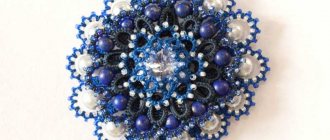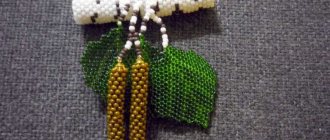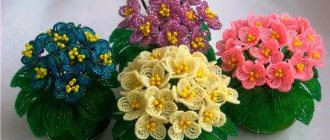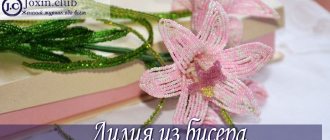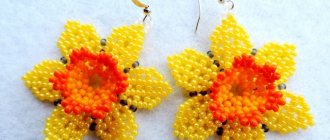Decorating yourself and your home is in women’s blood. They began to do this from time immemorial, and nothing could stop them in this field, not even limited resources. The appearance of bugles became a real holiday, because it opened up a new promising direction in needlework - beadwork.
The things coming out of the hands of craftswomen amaze with their beauty. There are a lot of things that crafters make, but today we will look at a specific topic: how to weave a tree from beads.
Do you think it's too complicated and beginners should try something simpler? You are right, but only partly. It will be boring for an adult woman to tinker with earrings or a children's bracelet, and among beaded trees there are plenty of options that even ladies who have a very vague idea of handmade can handle making. So, let's take a closer look at beading.
General order of formation
The process of creating the base structure occurs in stages:
- The first is that branches with leaves are woven. How does this happen? A certain number of beads are strung on a wire, for example, 10 pieces - they are moved to the middle, a loop is formed by twisting the wire approximately ten times. The next step is to repeat the action at both ends of the wire, while stepping back 1 cm from the twisted loop with bugles. In this way a branch with petals is formed. If it is necessary to add splendor to the tree, then construct 50-100 branches.
- Secondly, the clusters are connected to each other, forming a tree trunk. This happens in a neat one-by-one order, attaching one element at a time, and so on until a complete miniature giant is formed. A mandatory trunk holder inserted between the branches is a thick wire or a strong rod made of something.
- Third, a stand is prepared (deep or not very deep), where the created creation is placed, first filled with gypsum mortar.
How to weave rowan
Material:
- green and orange beads (No. 9 or 10);
- wire (No. 3) and thicker;
- metal or wooden stick for the barrel;
- brown iris threads;
- building gypsum;
- container for fixing wood, foil;
- acrylic paint, varnish, gloss.
Process:
- Prepare 27 pieces of thin wire about 40 cm long.
- Take one prepared wire, step back 10 cm from the edge and form a loop of 7 beads. Twist it around several times.
- Having skipped 1.5 cm from the first loop, put 7 more beads on the wire and make another loop, twist it. Also make 7 more loops.
- Fold the wire with loops in half and twist the free sections together. It turned out to be a twig.
- Make 18 branches in this manner.
- The next stage is larger branches. Cut pieces of wire 50 cm long.
- Retreat 10 cm from the edge. Make 9 loops from 7 beads. Fold in half, twist. The result was a larger branch.
- You need to make 27 similar branches.
- Now we need to make bunches of rowan berries.
- Cut the wire 20 cm long. Step back 10 cm from the edge, string an orange bead and twist it a little. Then string 1 more bead and twist. 2 berries on legs appeared. Also make 4 more berries and twist the free sections of wire. The bunch is ready. You need to make 18 bunches.
- Now all the elements for creating rowan are ready. Distribute them into 9 parts. Let's start making wood.
- On a piece of thick wire, first tie a bunch of threads, and then twigs. First, screw the short branches, then the long ones.
- You should get 9 branches with clusters. In the same way, from these 9 branches you need to make 3 lush ones.
- Take a wooden or metal stick and firmly attach the resulting branches with clusters to it with threads or wire.
- At the end of the trunk, bend or twist the wire so that when fixed in plaster, the mountain ash holds tightly.
- Line the bottom of the container with foil. Pour a gypsum solution of the required thickness there. Let it harden. Coat the rowan tree trunk with the same solution.
- Paint the trunk with brown paint and the area of plaster around it with green paint. Cover with varnish. You can sprinkle green beads along the bottom for decoration.
Rowan is ready.
Weaving technique training
Since there is a huge number of different trees, therefore, the scheme and design of each one is special, individual. Before preparing, let's take a look at what tools and materials are needed for the job!
- Wire (thin for branches and thick for trunk).
- Beads.
- Yarn, tape.
- Acrylic paints.
- Varnish.
- Gypsum.
- PVA glue.
- Scissors, nippers.
- Decorating elements - pebbles, floral moss, figurines, pearl beads, seed beads.
- The container where the structure will be located.
For needlewomen, many creative schemes have been invented, with the help of which you can design whatever you want.
Schemes in the photo
Let's look at different types of options.
What you need for beading
Before you start weaving wood, you will need to go to a store that offers handicraft supplies, or order all the necessary materials and equipment from a specialized online store.
To make a decorative tree you will need:
- beads of different shapes and colors;
- beads;
- sequins;
- colored wire - thick and thin;
- floral tape;
- threads;
- glue “Moment” or PVA;
- plaster or alabaster;
- rigid rods;
- sand, decorative stones;
- small figures;
- moss;
- container for stand;
- foil;
- pliers, round nose pliers;
- scissors;
- ruler;
- tassels;
- paints (acrylic or gouache);
- varnish;
- tailor's meter.
There’s no need to be scared; you shouldn’t go and buy everything. This is a general list. In fact, most of this “wealth” accumulates over time in any master; individual tools are then purchased as needed.
Some things you can find and prepare yourself, for example, sea or river pebbles, moss, pebbles, sand. Decorative figures are made by hand. To begin with, you should choose the simplest lesson and purchase only what you need to weave a particular tree.
Beautiful trees of love and fidelity
There is a sequence of formation and in order to achieve the goal, you must first have patience, perseverance, attentiveness and, of course, not miss the advice of professionals in this matter.
In yin-yang style
It is created by intertwining with each other, from two small intertwined similar options. Moreover, you can come up with two colors yourself, in this case black and white. Its originality lies in the fact that the trunk does not need to be painted or plaster, but only wrapped with threads. Then you need to place it in a round stand, strengthen it with plaster mortar and decorate it with the same beads. The technique is suitable for beginner needlewomen. We invite craftswomen to create a yin yang here by studying a step-by-step lesson.
Happiness made of beads and stones
Such a tree is believed to bring health, happiness, love and prosperity. If you use expensive stones in the structure, beads or beads that attract with their beauty and brightness, you will end up with a tree that attracts good energy and happiness will come in life. The most commonly used stones are rose quartz, aventurine, turquoise, sapphire, granite stone or mother-of-pearl plates.
Let's look at a simplified weaving method. First, 5 pieces of twigs with seven pebbles are created from wire - for the top. For the second tier - 8 branches with nine jewels and the third tier, consisting of 12 branches with eleven stones. Next, the clusters are connected to each other in groups and great “happiness” is formed. The roots are separated to the sides in the form of rays, then twisted for a stand. In conclusion, the created creation can be decorated in different ways: on a wooden stand, decorated with decorative moss, or plastered in a shallow container and the surface decorated to your taste. Follow this link, where you can easily take a master class on weaving a tree of happiness.
Amazing tree of love
The idea is to make a piece of beads of different sizes in the shape of a heart. Symbolizes the fulfillment of cherished desires. It is woven in the form of flowers, petals using French weaving or parallel, using the loop method. An elastic thick wire is allowed, with the help of which the shape of the heart is formed and fixed. Give free rein to your imagination and you will definitely end up with a unique piece. Follow the link and find a detailed tutorial on how to create a love tree from beads.
Cherry blossoms
Sakura is the national symbol of Japan and the structure of the flower consists of five petals. The Japanese believe that each of the petals has its own purpose - health, prosperity, peace in the family, joy and love.
Sakura made of beads, alluring with its appearance, has never left anyone indifferent. Japanese style will perfectly decorate your home with soft pink shades and add warmth and friendliness to your guests. It can be made using a lush and bright loop method, or you can give it less volume, then the sakura will turn out delicate and fragile, or using French weaving, that is, creating large flowers using circular bead weaving. You can learn about making trees from a step-by-step description of various options for weaving sakura and final arrangement on a stand, decorating it in a variety of ways.
Delicate bride woven with beads
The name already speaks for itself. The bride is created from small branches, using white beads or large pearls. The technique is a loop technique with twisting several turns to create bird cherry inflorescences and petals. The “bride” bouquet, created from wire and beads, decorated with an elegant ribbon, looks very original.
Types and sizes.
You don’t need to buy the first bead you come across; you should look at its quality. The quality of beads can be determined by its manufacturer. Beads vary in shape as follows:
- Ordinary. Small beads with a round or square hole.
- Chopping. Small tubes up to 2 millimeters long.
- Bugles. Long, faceted tubes 3-25 millimeters long.
As for the manufacturer, the highest quality beads are made in the Czech Republic or Japan. When choosing beads, you need to carefully inspect the bag so that there are no defects in it.
DIY beads and sequins
A peculiar tree that does not look like a picturesque one, but it looks beautiful and original. The modification is created in different ways, for example, willow, birch, autumn from sequins, sakura looks extraordinary with pink sequin flowers, a tree with red beads and green sequin leaves. As you may have guessed, you can use a fantasy of different figured sequins, which will later become exclusive in your home collection.
We invite you, dear needlewomen, to create according to nature and the seasons.
Basis for weaving.
Bead weaving uses a large number of wires of various diameters. The main ones:
- Diameter 0.2 millimeters. Used to make small items.
- Diameter 0.5 millimeters. More rigid parts, flower frames and stems are made from it.
- 1 millimeter in diameter. Rigid parts are made from it, for which 0.5 mm wire is not suitable.
Autumn mood
With the arrival of autumn, as you know, nature takes on a golden appearance. Therefore, beads of the following shades take part in weaving: yellow, orange, gold, and sometimes light green. All these colors can participate in the creation of a single tree, smoothly transitioning from one color to another. You can use a loop technique for leaves, or you can weave maple leaves, then connect them and shape them in their likeness, planting them in a pot of plaster. You can study a detailed master class by following the link: delightful autumn compositions.
White birch
A woven birch tree, either made of beads, stones or sequins, looks very fascinating.
It is especially beautiful when using different shades of green. The height of the product can vary from 25 cm to 50 cm. Detailed instructions can be found here: white birch made of beads with a diagram and photo. The technique is looped, branches are formed of different sizes. For example, a small birch tree can be woven in this way:
- Thread a little glass bead onto a 60 cm wire, twist a loop four times out of five beads, then form two similar loops.
- You will get a small twig and continue to weave it using a loop method on a segment of 5 cm, picking up five beads for one loop.
- These loops need to be formed in 12 pieces and the third branch is woven on the remaining piece of wire.
- The result will be one branch consisting of three small branches. It follows that a birch tree will look beautiful with such clusters formed on one leg and eliminates excessive thickening.
Video tutorial on Russian birch with beads
It is large in size and is woven using a different technology, with thicker branches. The process is very simple:
- A large number of beads are collected onto the wire and ears are created from seven glass beads, formed in a row of 12 loops or more.
- Then bend the wire in half and twist the loops together.
- A lot of such branches are made (60 pieces) so that in the end you get a lush tree.
- The barrel is made in a very interesting way, painted in an artistic style with white gouache, and finally coated with acrylic varnish.
Master class on rowan beading
“The technique is somewhat more complex than beading a bonsai tree, so beginners can spend quite a lot of time making the required 187 green pieces.”
Looking at the finished works, sometimes it seems that weaving a Dionysus tree or a rowan tree from beads is extremely difficult. However, in practice everything is not so scary. Even beginners can take on such a project. This is truly an exciting and exciting event. The masterpiece that comes out of your hands can turn out to be more than realistic if you are not too lazy to strictly adhere to the recommendations of the masters. Let's look at the sequence of the process using the example of creating an impressively beautiful rowan tree.
What to cook
1. Beads in two shades: orange-red and green. You can take material made in Czech or Chinese. In the first case, the size of the beads is No. 10, in the second – No. 12.
2. Wire with a cross section of 0.3 mm and thick, which will be needed for the barrel.
3. Threads or masking tape for wrapping branches.
4. Brown paint.
5. Alabaster.
6. Varnish.
Work on a beaded rowan tree begins with weaving its clusters. This is a prefabricated element. To form it you need to prepare five small bunches of berries.
Weaving rowan berries
This is done as follows. We cut 33 cm from a coil of thin wire and collect 3 orange-red bugles per piece. Move them 5 cm from the edge of the wire and twist the loop. The length of the twist on the wire is 1 cm. Again we collect 3 beads and repeat the manipulation. In total, 10 such elements should appear on the wire segment.
10 berries should appear on the segment
The next step is to collect all the “berries” into a bundle by twisting the wire ends. We make 4 more similar blanks and form a bunch. For a small tree we need 11 full bunches.
Collect all the “berries” into bunches
The second stage will be the creation of the deciduous part of the crown. Here we will use a parallel beading technique. To work, you will need a piece of wire 25 cm long. We will string a green bead onto it and place it in the center.
Parallel Beading Technique for Leaves
Now let's take the end of the wire (which one does not matter) and thread it into the same bead, but in the opposite direction. Let's tighten the knot. Next, we put two beads on the wire and repeat the procedure with the return of the wire. Tighten the ends, firmly fixing the new row.
Creating the deciduous part of the crown
In the third row there will already be three bugles. We repeat the steps for passing the wire back.
In the same spirit we weave the next two rows. But starting from the sixth row, the leaf will begin to decrease, so not three, but only two beads will fall on the wire, and in the seventh, respectively, one. The remaining free wire ends are twisted. The technique is somewhat more complicated than weaving a bonsai tree from beads, so beginners can spend quite a lot of time making the required 187 green pieces.
Finished bunch and leaf
When everything is ready, we will form an original rowan leaf from single elements. First, we will twist three leaves together, then we will wind a pair of parallel parts onto the resulting rod. The step distance between pairs is 0.5 cm. There will be three such pairs in total.
Wood assembly
The most critical stage. Here you will have to think about how to assemble the branches into a single whole in order to get a beautiful crown. You may have to disassemble the craft more than once and redo it again. There's nothing wrong with that. In bead weaving, trees rarely turn out perfect the first time, even by professionals, so shape the crown as much as you see fit, that is, until you are satisfied with what you see.
Gather the branches into a single whole
To collect the crown, you need to prepare branches. To do this, we connect a bunch and a large leaf in pairs. Below along the wire we attach the next leaf and bunch. We repeat the procedure again. The first crown branch is ready.
Having assembled the remaining pieces according to this principle, we begin to assemble the composition. Now a thick wire will go to work, to one end of which a branch will be attached. This will be the center around which the crown will form. Fix subsequent branches at a certain distance from each other, bending in the appropriate direction. For strength, wrap the elements well with tape or plaster. The latter should be fabric or paper.
Beaded rowan branch
Now let's make a stand. Let's dilute plaster or alabaster to the consistency of sour cream and pour the solution into a suitable container. Let's lower the wire bottom of the tree into it and let it harden.
Next are some tips on how to properly plaster wood from beads for beginners. It will not be possible to add volume to the trunk by pouring the compound, so we will use small, 10 centimeter pieces of wide bandage. This is what we will impregnate with plaster and wrap it around the wire in the stem part. Most likely, you will have to do this several times. Here you need to focus on the adequacy of the height of the tree with the width of the trunk.
Rowan beads
Next, we coat all the branches with gypsum solution, after covering the decorative part with cling film. Let it dry thoroughly and paint it brown. You can use acrylic, oil or gouache paints. The finishing touch will be the varnishing of the wood part of the composition and the design of the stand. Specific master classes will tell you how this can be done.
Winter in the snow
The fairytale tree is woven from silver wire with white beads or silver, transparent beads. The technique is a loop, or it can consist of forming sticks by stringing beads onto a wire of about five centimeters, and then using one of the ends to pass through half of the collected pieces of glass. You will get a tight loop in the shape of a stick. And then again with the end of the wire we pass through the remaining part of the beads and two branched branches are formed - one central, the second lateral. In this sequence, we finish the weaving, again picking up a certain number of beads and using this technique we complete the structure, consisting of three or four sticks on a branch. You need to weave a lot of small, medium and large branches. Take two elements of different sizes and twist them together. Finally, the branches are gathered together using thick wire and the crown of the tree is formed. As a rule, the tree is eventually planted in plaster.
We have prepared a training especially for you with step-by-step instructions for making an ice tree.
Additional tools
To weave beaded trees you will need the following tools:
- Small pliers;
- Wire cutters to cut wire of the required size;
- A small container in which the plaster will be diluted;
- Glue;
- A napkin or tablecloth to keep the table clean;
- Beads;
- A container in which the beads will be mixed;
Blooming apple tree
You can create a similar composition in two options, the first is using the loop technique, the second option is circular weaving. Externally, these woven trees are very different from each other and each one looks beautiful. Apples are created from large beads or cold porcelain. In order to learn in detail how beaded fruit trees such as apple, cherry or citrus fruits are made, you need to watch several lessons on our website.
Weeping Willow Beading
This tree has a very interesting and easy technique. The process consists of stringing beads onto a wire and then scrolling them one by one in one row. Many willow branches are made (from 200 to 500 pieces), then they are collected together, the trunk is attached and placed on a stand. You can decorate the pot with artificial moss, grass, pebbles, and flowers. After the work done, our crybaby looks simply amazing. You only need to stock up on green beads, wire, desire and patience to achieve the desired result.
Decorating the trunk
Try on your plaster blank according to the size of the main container intended for support. It is necessary that the small container fits completely into the main stand.
The execution sequence is as follows:
- Now wrap the main bowl in foil and remove the small bowl.
- Place one stand inside the other. Dilute the plaster and fill it with it.
- You need to pour in small portions so as not to make a mistake with the amount of gypsum.
- Once dry, remove the foil from the stand.
- Take small strips of foil and use them to form the roots and trunk of the tree.
- Now proceed to gluing the barrel with a paper towel, using PVA glue and a small amount of water.
- Glue the stand together with the barrel.
- Cut narrow ribbons of paper towel and wrap them around the trunk. Start at the bottom and gradually work your way up.
- When finished, coat the entire surface with glue.
- In the same way, cover the entire trunk. Your branches should remain free. They need to be decorated only after attaching deciduous branches.
- Glue the stand with a second layer of paper for strength. For convenience, you can immediately add paint to the glue.
- Once the stand is dry, you can move on to the top part.
- Paint the roots and bottom of the tree trunk dark colors. For strong support, use paints mixed with PVA.
Beaded money tree
Many people want to create a money talisman from beads and decorate their home. At the same time, hoping that it will subsequently bring good luck and prosperity to the house. It is woven using coins and using green or gold bugles, which will give a special feature to such a work. For you, needlewomen, how to build a money tree, as well as a video lesson on the “golden miracle”.
A wide variety of coins are suitable, Chinese, decorative, real, as you please. Taking real coins, you can drill a hole at the edge; decorative ones are already made with a hole. The technique used is different, because everyone has their own taste and certain weaving skills. For example, branches are woven in a loop (the more branches you weave, the more magnificent the tree will be), looped with turns, and clusters are also created in a parallel way. Or you can even weave it altogether, just by using decorative coins, without beads.
Video lesson on weaving a golden miracle
Weaving patterns and how to read them
Creating crafts or jewelry from beads requires perseverance, diligence, and a strict sequence of actions. For this, many schemes have been developed to help you choose the right size and amount of material. They can be found in special magazines, newspapers, and downloaded from the Internet. Not all materials contain complete information or a detailed description of the progress of work. Often the problems are:
- The beginning and end of the diagram are not indicated;
- The rows are not numbered;
- It is difficult to understand the direction of the thread when weaving;
- Poor print quality, unclear image;
You should start learning by mastering basic techniques. The more practice you have, the clearer more complex patterns will become. Such processes will be deposited in tactile memory; when visually perceiving the pattern, indicating the direction of the thread will no longer be necessary.
On any beading pattern, the details are marked with circles and highlighted in color. The numbers at the beginning of each row indicate the number of beads. The number of rows is marked above the picture. If the product is multi-colored and voluminous, then next to each dot there will be a number indicating the number of beads in one set.
Lush wisteria
It is very beautiful in appearance with sweet scented flowers, with hanging branches like a vine. It grows in China, in the forests of Japan. Shades of purple, pink, and sometimes mixed with yellowish and green leaves are used in beadwork. Our tutorial on creating delicate wisteria will tell you how to make a composition using a completely simple technology. The branches are woven in a looping manner by placing many beads on a long piece of wire, then twisting the process to form a branch. Having made a large number of branches, they need to be fastened together. The more clusters, the more luxurious your craft will look, planted in a stand with plaster mortar and decorated with a unique decor. We suggest following the link flowing wisteria, where you will see photos of beautiful trees with detailed instructions for creating your creation.
Love tree
Making a heart-shaped product with your own hands and giving it to a dear person, for example, a mother or friend, on Valentine’s Day will be an excellent gift.
A detailed master class will tell you how to create a beautiful decoration and at the same time have a lot of fun. It is very good to involve children in this work; they will not find it monotonous, since the craft is unusual and the process is interesting.
Preparing for work
Before you start beading, I advise you to purchase a bead spinner. This will make your work process easier. You will need the following material:
|
and:
|
Master class on creating a heart from beads
In this process, two colors of glass beads are used - white and red.
Flower
You need to make 7 flowers from white beads.
- Fold the 80 cm long wire in half, but not in half. Make one tip 10 cm longer. We collect seven beads on the spinner, lower them to the fold and twist them into a loop with three turns.2. Next, we collect 17 pieces of bugles and make a loop-shaped grip along the top and twist it three times. The petal is made from two loops.
3. Make the third loop of thirty beads. Look at the bottom photo to see what the petal should look like.
Important! Twist all the loops three times, then the flower will turn out without a large space in the middle. A small hole can be decorated with some kind of bead
4. We weave the second petal in a similar way. The leg of the twist should be approximately 1.5 cm and only then we form a loop.
5. Connect them so that the second lies slightly on the edge of the first. We weave three more petals in the same way. This is the flower you will get.
6. Using the same principle, we weave 13 flowers from red beads.
Branches
You will need to weave 14 white branches, and 20 red branches.
| We string a rice-shaped bead onto the middle of the 80 cm wire and twist it seven turns. |
| We stretch the pearls from one side of the wire and bend the loop about 1 cm, twist it to the end of the loop. Don’t forget to twist the formed loops with beads between each other in pairs of turns. |
| We do the same with pearls at the other end. The result is this part of the twig. |
| By alternating, we further create small elements of branches from the beaded accessory. We collect about 17 white beads on the spinner and form a loop. On the other side, we will make a loop from a transparent droplet. You can see how it looks in the photo. |
| You can finish weaving a twig with different beads at your discretion. For example, to weave a branch like the one in this picture, add a rice bead, a pearl, and six white beads in the shape of a loop. |
Lay out all the beading pieces in front of you. We will put the whole composition together.
Heart decoration
The base of the heart is divided into two parts and since the bend is uneven, we will fill the smaller part with white weaving, the other with red.
First we apply a white branch to the heart-shaped blank and wind it in the form of a spiral, as shown in the photo.
Next, we apply the flower and twist it around the base in the same way. Look how beautiful the element looks.
We wrap the heart with twigs, alternating in different directions.
The design initially occurs in this order: a twig, a flower, two branches on opposite sides, a flower, and so on. This is what the completed design looks like.
To make the craft look more beautiful, you need to tightly tie the weave of wire with white threads.
We finish the weaving of the second side from red twigs and flowers in a similar way. Look at the photo below to see what the weaving of beaded elements looks like.
In a similar way, we cover the wire with scarlet threads carefully and slowly, so that your creation does not lose its beauty.
Heart beauty design
When a charmingly beautiful composition is finished, it is necessary to adequately decorate it.
|
|
We hope that the section on making trees of happiness was useful and interesting for you. There are many options for craft stands, such as:
Good luck with your new creations!
Dionysus
Where did this name come from? In ancient Greek mythology, it is believed that this is the god of the fertility of vegetation, viticulture, which means that the difference in appearance is the presence of small clusters. In this work you can get creative with the color scheme; usually bright colors are chosen and woven in the form of large berries of any shape. Beading occurs using a loop technique consisting of three blanks with five loops. As a result, these three branches are connected by twisting and a bud is obtained. Then two identical buds must be twisted together and a beautiful cone is formed. The ancient Greek Dionysus is created from two colors, for example, red - cones and green - petals.
Materials
First of all, let's look at the list of materials for creating trees. Mainly used for work:
- Beads of different colors and sizes;
- Copper wire;
- Scissors;
- Napkins or a piece of velvet (from scattering on the table surface);
- Flower pot or other container;
- Masking tape;
- Threads, yarn;
- Sand, soil, gypsum for placing the trunk.
The range of materials may vary depending on the model. To begin with, you can practice on simple trees without denying yourself the pleasure of creating an aesthetic piece.
Interesting fact
Tradition says that each tree carries a miraculous sign and is a specific talisman. For example, pine is characterized as increasing productivity and prosperity in a career; sakura is a symbol of tenderness, love, devotion and purity; Rowan - protects against negative energy and improves health; monetary – luck and prosperity in the house; yin-yang - peace of mind and harmony of opposites, and so on.
Maybe someone is now learning this type of folk art, and later will reach the professional level. And of course he has an idea about the many different types of trees, all that remains is to choose what he would like to make. The size of the product can range from small to large, it all depends on desire and imagination.
